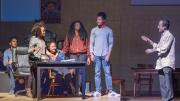I studied for my first set of college finals in Harvard Law School’s student center. Lamont Library, frequented by first-years, gave me too much anxiety, so I made myself a study spot on a law school couch. Every day for a week, I went back to study calculus in that unfamiliar place, because I wanted to feel invisible. The architecture of Wasserstein and the adjoining Caspersen Student Center doesn’t feel grounded in old history the way other buildings do. Perhaps its contemporary feel is meant to convey a certain degree of malleability—that the space could be what students make of it. But back then, the hall felt emotionless and sterile.
When I returned to the law school this February, the hall had been remade. A group of students called Reclaim HLS had occupied and renamed the space Belinda Hall, after Belinda Royall, a woman enslaved by the Royall family; part of the Royall fortune underwrote the first professorship of law at Harvard. She petitioned the Commonwealth of Massachusetts for reparations at age 63, in 1783, and was granted a pension of 15 pounds, 12 shillings—to be paid from the estate of Isaac Royall. Her petition is one of the earliest successful calls for reparations.
Reclaim HLS had filled the space with students who had reached out across the University and beyond to form a community of change-makers that included other students, workers, staff, professors, and any other folks who expressed interest in engaging with them and the work they are trying to do. The student center is open 24 hours a day to HLS students, so the occupiers took up their school’s offer: they slept there at night, hung out there all day, and organized fireside chats, reading groups, lectures, birthday parties, and any other programming they saw fit.
Almost two months later, they remain active. Reclaim HLS issued a set of demands for the Harvard administration last December, but they aren’t waiting on the dean of the law school to make the changes they want to see. Alongside their calls for critical race theory courses and learning that incorporates discussion of race, class, nationality, gender, religion, and sexual orientation into classroom readings in the law, Reclaim HLS themselves host political-education study groups multiple nights a week. They invite professors of color and community members to come teach what isn’t being taught in formal HLS classrooms. They tackle papers and books together and inject their personal experiences into the learning process. They create and live the school they want.
Inspired by the folks in Belinda Hall, I took my own look at some Harvard history. I read Harvard Magazine’s April 1969 strike coverage because I wanted to learn how institutions change. I knew that the activism of black students then at Harvard got us our African-American studies department and an Afro-American Cultural Center (which no longer exists in any kind of permanent physical structure). I also knew that my choir, The Kuumba Singers of Harvard College, was founded in the same spirit by a group of black students in 1970.
Nicholas Gagarin ’70, then the managing editor of The Harvard Crimson, described being part of a small group of what he called “apolitical students” who chose to join the occupation of University Hall. His reflections on the strike were unforgettable:
…Instead of asking for it, trying to play the University’s game—all we have to do is do it.
As a first step toward this, it might be worthwhile—as we shut down this university whose veritas we have seen to be a lie—to set up a new University, a University of our own, which could exist right in the middle of Harvard Yard. It would be totally open, its “courses” would be whatever the students and faculty present at any given time wanted to talk about, sing about, or dance about. And it would dedicate itself to the kind of truth whose power lies in the overwhelming fact of its own rightness—not in the pocketbooks of some distant Corporation or the nightsticks of the pigs they can call at will to protect them.
I sought out knowledge about 1969 expecting to learn about tactics, about the formulation of demands, about what student activists got from Harvard. But Gagarin’s writing reminded me that activism isn’t necessarily about the back-and-forth between those demanding change and the higher-ups to whom they direct their appeals.
This lesson, the idea that permission isn’t required to start living the change you want to see, is being systematically put to work far beyond this University, by the organizers of Black Lives Matter. They have famously interrupted presidential candidates’ rallies and speeches, but they aren’t depending on elected leaders as the ultimate source of liberation. In an interview with the Democracy Now! news show, Black Lives Matter organizer Melinda Abdullah explains the decision not to endorse a candidate: “We want to put our time and energy in the development of people to act in their own interests and on their own behalf.”
Activism isn’t solely about asking authority for the things you want. It’s about creating the world you want for yourself, right now. Nicholas Gagarin knew this. Black Lives Matter knows this. And this kind of radical imagination is exactly what’s at work in Belinda Hall.
The students there are tactically and ideologically influenced by the work of Black Lives Matter not just because those techniques are effective, but also because they recognize the inherent connection between oppression at the University and the broader injustices of society. Their goal isn’t just a less oppressive Harvard—it’s a less oppressive world. They cannot watch marches on the streets of our cities without indicting their own institution for producing lawmakers, policymakers, and officials who are a part of the problem.
I want institutional change at Harvard. I want above-ground cultural centers for students of color at Harvard. I stand in solidarity with my friends who are fighting for Latino/a studies, Asian and Pacific-American studies, and Native studies, so that their histories can be formally acknowledged at an educational institution that calls itself one of the best in the world. I want the administration to do things.
But students have already been doing things themselves, and we should acknowledge their contributions. Even though Harvard hasn’t given us cultural centers, we have been building our own cultural centers without bricks. A friend of mine recently held his senior recital—a voice performance exploring the work of African-American jazz musicians in Paris—in Paine Hall, whose walls bear the names of white, Western classical musicians. For the occasion, he decorated the walls with signs bearing the names of black jazz greats. My friends and I are putting up an original all-black play on the Loeb mainstage. There are students of color writing theses that insert the stories of their people into the archives.
We cannot forget that injustice at Harvard, like injustice everywhere, ultimately lands on the body. It lands on the bodies of academics of color who furiously publish and mentor, taking on physical and emotional labor that may not be asked of their white counterparts. It lands on the bodies of Harvard workers’ family members whose necessary surgery is financially out of reach. I do not believe that I can imagine these realities away. But I do believe that imagination-work is valuable—it allows us to affirm that there could be other ways for us to live and relate to each other.
The poet Ross Gay, in his lecture at the Radcliffe Institute in February, talked about the ground. He said that there is a ground on which black lives do not matter. There is a ground on which black people only exist to suffer—to be marginalized, oppressed, beaten, killed. But he told us that this is a ground that he does not abide. We need to create spaces where death, suffering, and erasure are not the only narratives. We need to recover histories that tell of our living, too.
Before I was here, black theater and black concerts and black joy were rattling the walls of these brick buildings. I celebrate the stories of people who resisted this institution’s mold and created their own spaces within it. I am indebted to acts of resistance, from Belinda’s petition to the reading groups organized by a diverse and dedicated group of students in the hall they have named for her.
Institutional change is necessary, but it can be slow and incomplete. I believe in creating spaces and worlds, right now, where we can assert our dignity and affirm the dignity of others without asking for permission. There are hierarchies—on our syllabi, on Harvard’s payroll, in Harvard’s social real estate—that I do not abide. And I insist that the work of re-imagining these realities manifests in concrete ways. The process of rejecting these hierarchies on our own terms, and learning about those who have been doing so all along, reinvigorates us with new possibilities for our lives.








